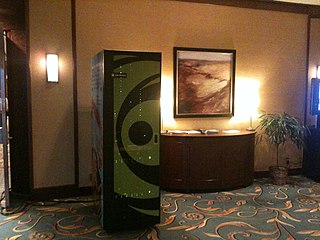
PostgreSQL also known as Postgres, is a free and open-source relational database management system (RDBMS) emphasizing extensibility and SQL compliance. PostgreSQL features transactions with atomicity, consistency, isolation, durability (ACID) properties, automatically updatable views, materialized views, triggers, foreign keys, and stored procedures. It is supported on all major operating systems, including Windows, Linux, macOS, FreeBSD, and OpenBSD, and handles a range of workloads from single machines to data warehouses, data lakes, or web services with many concurrent users.

Ingres Database is a proprietary SQL relational database management system intended to support large commercial and government applications.

Db2 is a family of data management products, including database servers, developed by IBM. It initially supported the relational model, but was extended to support object–relational features and non-relational structures like JSON and XML. The brand name was originally styled as DB2 until 2017, when it changed to its present form. In the early days, it was sometimes wrongly styled as DB/2 in a false derivation from the operating system OS/2.
Business intelligence software is a type of application software designed to retrieve, analyze, transform and report data for business intelligence (BI). The applications generally read data that has been previously stored, often - though not necessarily - in a data warehouse or data mart.
ER/Studio is data architecture and database design software developed by IDERA, Inc. ER/Studio is compatible with multiple database platforms and is used to create and manage database designs, as well as to document and reuse data assets. In 2015, Embarcadero Technologies was acquired by database and infrastructure management software company IDERA, Inc. Since the acquisition by IDERA, Inc., ER/Studio has been renamed to ER/Studio Data Architect with updated features.
In computing, the term data warehouse appliance (DWA) was coined by Foster Hinshaw for a computer architecture for data warehouses (DW) specifically marketed for big data analysis and discovery that is simple to use and has a high performance for the workload. A DWA includes an integrated set of servers, storage, operating systems, and databases.

Navicat is a series of graphical database management and development software produced by CyberTech Ltd. for MySQL, MariaDB, Redis, MongoDB, Oracle, SQLite, PostgreSQL and Microsoft SQL Server. It has an Explorer-like graphical user interface and supports multiple database connections for local and remote databases. Its design is made to meet the needs of a variety of audiences, from database administrators and programmers to various businesses/companies that serve clients and share information with partners.

IBM Netezza is a subsidiary of American technology company IBM that designs and markets high-performance data warehouse appliances and advanced analytics applications for the most demanding analytic uses including enterprise data warehousing, business intelligence, predictive analytics and business continuity planning.

Greenplum is a big data technology based on MPP architecture and the Postgres open source database technology. The technology was created by a company of the same name headquartered in San Mateo, California around 2005. Greenplum was acquired by EMC Corporation in July 2010.
ParAccel, Inc. was a California-based software company.
Amazon Relational Database Service is a distributed relational database service by Amazon Web Services (AWS). It is a web service running "in the cloud" designed to simplify the setup, operation, and scaling of a relational database for use in applications. Administration processes like patching the database software, backing up databases and enabling point-in-time recovery are managed automatically. Scaling storage and compute resources can be performed by a single API call to the AWS control plane on-demand. AWS does not offer an SSH connection to the underlying virtual machine as part of the managed service.
A cloud database is a database that typically runs on a cloud computing platform and access to the database is provided as-a-service. There are two common deployment models: users can run databases on the cloud independently, using a virtual machine image, or they can purchase access to a database service, maintained by a cloud database provider. Of the databases available on the cloud, some are SQL-based and some use a NoSQL data model.
SingleStore is a distributed, relational, SQL database management system (RDBMS) that features ANSI SQL support, it is known for speed in data ingest, transaction processing, and query processing.

CARTO is a software as a service (SaaS) spatial analysis platform that provides GIS, web mapping, data visualization, spatial analytics, and spatial data science features. The company is positioned as a Location Intelligence platform due to its tools for geospatial data analysis and visualization that do not require advanced GIS or development experience. As a cloud-native platform, CARTO runs natively on cloud data warehouse platforms overcoming any previous limits on data scale for spatial workloads.
Actian is an American software company headquartered in Santa Clara, California that provides analytics-related software, products, and services. The company sells database software and technology, cloud engineered systems, and data integration solutions.
Presto is a distributed query engine for big data using the SQL query language. Its architecture allows users to query data sources such as Hadoop, Cassandra, Kafka, AWS S3, Alluxio, MySQL, MongoDB and Teradata, and allows use of multiple data sources within a query. Presto is community-driven open-source software released under the Apache License.
Amazon DocumentDB is a managed proprietary NoSQL database service that supports document data structures, with some compatibility with MongoDB version 3.6 and version 4.0. As a document database, Amazon DocumentDB can store, query, and index JSON data. It is available on Amazon Web Services. As of March 2023, AWS introduced some compliance with MongoDB 5.0 but lacks time series collection support.
Yellowbrick Data is a US-based database company delivering massively parallel processing (MPP) data warehouse and SQL analytics products. The company is headquartered in Mountain View, California.
HammerDB is an open source database benchmarking application developed by Steve Shaw. HammerDB supports databases such as Oracle, SQL Server, Db2, MySQL and MariaDB. HammerDB is written in TCL and C, and is licensed under the GPL v3.







